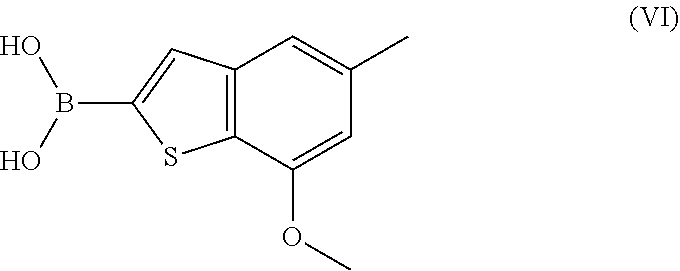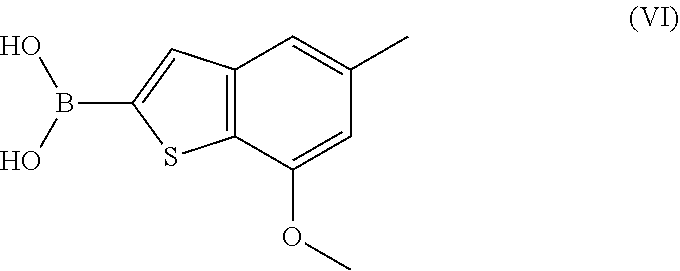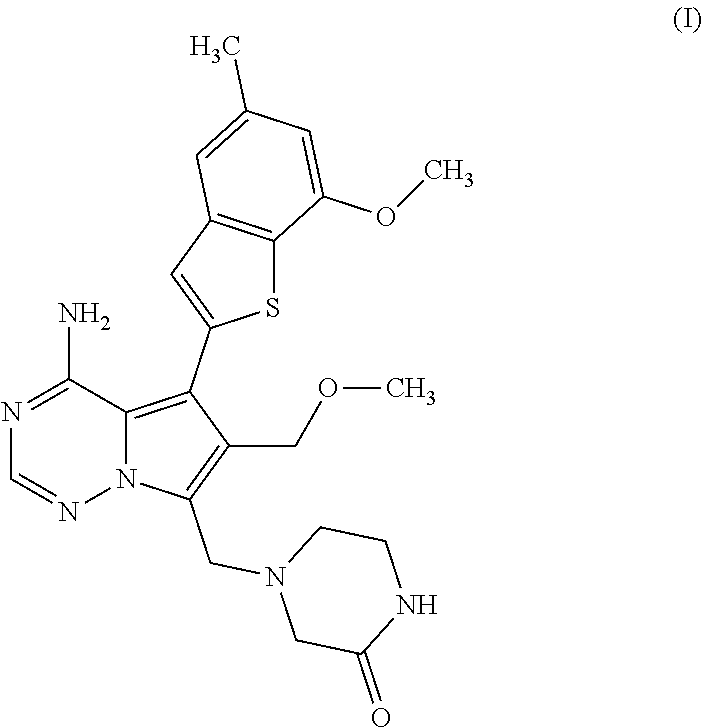Process for preparing benzothiophen-2yl boronate
- Summary
- Abstract
- Description
- Claims
- Application Information
AI Technical Summary
Benefits of technology
Problems solved by technology
Method used
Image
Examples
example 1
3-(Methoxycarbonyl)-4-(3-thienyl)but-3-enecarboxylic acid (XIII)
[0163]
[0164]256 kg of dimethyl succinate are initially charged in 296 L of methanol. 332 kg of NaOMe (30% in MeOH) are added over a period of 2 h at a temperature from 25-40° C. The reaction mixture is heated to 65-70° C. and a solution of 98.5 kg of thiophene-3-aldehyde in 20 L of methanol is added over a period of 4 h. The mixture is further stirred for 2 h and subsequently cooled to 30-35° C. The solvent is distilled off under reduced pressure at <55° C. (residual volume ca. 400 L). The mixture is cooled to 10-30° C. and 296 L of toluene and 788 L of water are added. The phases are separated and the aqueous phase is adjusted between pH 1-3 with conc. HCl. The aqueous phase is extracted a further three times with a total of 789 L of toluene and the combined organic phases are washed with a solution of 98.5 kg of NaCl in 493 L of water. The solvent is distilled off under reduced pressure at <60° C. and 197 L of toluene...
example 2
Methyl 7-acetoxy-1-benzothiophene-5-carboxylate (XII)
[0169]
[0170]73.1 kg of (XIII) are initially charged in 731 L of toluene and 115.5 kg of acetic anhydride and 32.2 kg of sodium acetate are added. The reaction mixture is heated to 70-75° C. for 7 h. 366 L of water are added at 25-30° C. and the phases separated and the organic phase is washed with 366 L of water. The organic phase is concentrated under reduced pressure at <60° C. up until a residual volume of 300-360 L remains. The crude product is used as a solution in the next stage.
[0171]The analytical characterisation was carried out on a sample from the following laboratory procedure:
[0172]204 g of intermediate (XIII) are initially charged in 720 mL of toluene and 230 g of acetic anhydride and 89 g of sodium acetate are added. The reaction mixture is heated to 70-75° C. for 7 h. After cooling, the reaction mixture is filtered, the filtrate is washed with 1 L of water and the phases are separated. The organic phase is washed w...
example 3
7-Hydroxy-1-benzothiophene-5-carboxylic acid (XI)
[0176]
[0177]146 L of methanol and 292 L of water are added to the concentrated crude solution of (XII) at 25-30° C. and a solution of 77.5 kg of NaOH in 366 L of water are added at <45° C. over a period of 1.5 h. The reaction mixture is heated to 50-55° C. for 5 h. The phases are separated and the aqueous phase is further diluted with 73 L of water. The aqueous phase is acidified to pH 2-3 with semi-concentrated sulphuric acid at 10-15° C. and then heated to 40-45° C. for a further 1 h. After slow cooling to 25-30° C. over a period of 2 h, the product is isolated on a centrifugal filter and washed with 219 L of water. After drying in the warm air dryer at 60-65° C., 57.5 kg of intermediate (XI) were obtained (yield: 92%).
[0178]The analytical characterization was carried out on a sample from the following laboratory procedure:
[0179]2.0 g of 4 were initially charged in 15 mL of ethanol and 5 mL of THF at room temperature and 20 mL of aq...
PUM
 Login to view more
Login to view more Abstract
Description
Claims
Application Information
 Login to view more
Login to view more - R&D Engineer
- R&D Manager
- IP Professional
- Industry Leading Data Capabilities
- Powerful AI technology
- Patent DNA Extraction
Browse by: Latest US Patents, China's latest patents, Technical Efficacy Thesaurus, Application Domain, Technology Topic.
© 2024 PatSnap. All rights reserved.Legal|Privacy policy|Modern Slavery Act Transparency Statement|Sitemap



